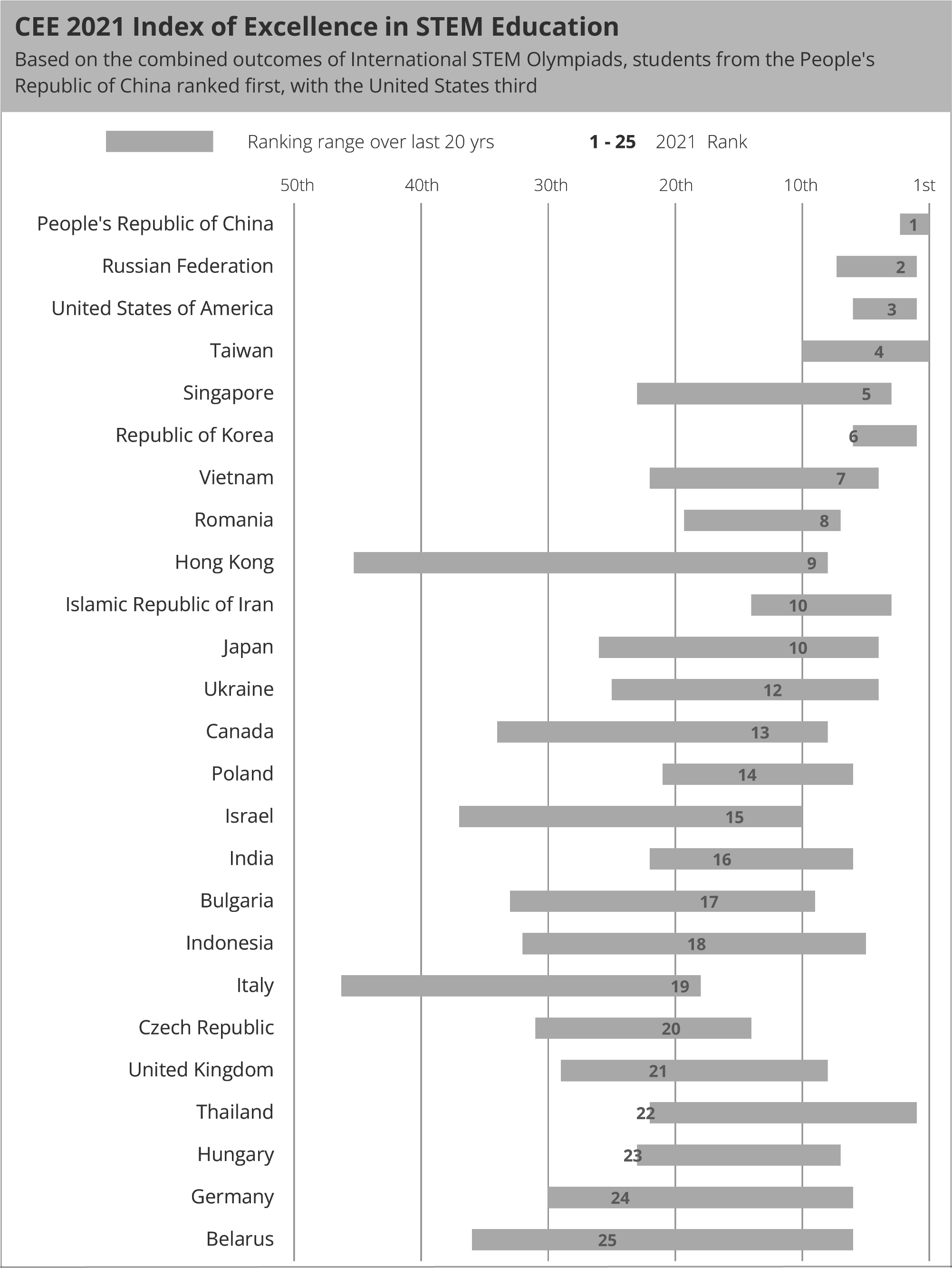
Analyzes Student Performance in STEM-related Global Academic Competitions; China Dominates
McLean, Va. (November 2, 2021) – Economic competitiveness is driven by scientific innovation of the nation’s top achievers. To track how well U.S. students stack up against those in other countries, the nonprofit Center for Excellence in Education (CEE) developed an index of science, technology, engineering, and mathematics (STEM) education preparedness.
The CEE Index of Excellence in STEM Education measures educational performance at the highest levels of international academic competition. The CEE Index analyzes individual student rankings in each of five STEM-related Olympiad competitions; generates averages and rankings by participating country; and compares overall Olympiad performance by country.
“The CEE index gives our policy-makers and educators an important tool to see how well our next generation of innovators compares to those in the rest of the world,” says Center president, Joann P. DiGennaro. “Chinese success at STEM Olympiads has correlated with the growth of the Chinese economy. This tool is critical to any analysis of how we prepare the next generation of leaders.”
Based on the combined outcomes of International Olympiads in Biology, Chemistry, Physics, Math, and Informatics, the index shows:
- The People’s Republic of China has dominated each of these events for the last 30 years.
- Students from the USA have continued to perform well, with either second or third place overall rankings for the last five years.
- The Russian Federation, also always a strong performer, is in second place.
- Taiwan in fourth place.
- Places 5 through 10 were captured by Singapore, Republic of Korea, Vietnam, Romania, Hong Kong, and Iran.
The index also shows that the performance of European students has declined as Asian countries have risen to dominate the Olympiads over the last few decades. Germany, for example, has now been forced out of the top 20, after having ranked number one in 1989, 1988 and 1982. Hungary, with a population only 1/8th the size of Germany’s, still managed a 23rd place finish; while respectable, that’s a drop from the 1st or 2nd place glory it enjoyed in the 1960s and early 70s. Remarkably, Singapore, an even smaller country with fewer than 6 million inhabitants (half the population of Hungary), ranked 5th place.
An analysis of USA Biolympiad Team’s performance from 1993 to the present shows a steady improvement in average ranking, from approximately 6th to 2nd or 3rd place behind China in recent years. Increased competition in the global marketplace has driven students to distinguish themselves through excellence in academic competition.
“In most other countries, the government funds Olympiad programs, including training and other resources for teachers and students,” DiGennaro says, “but that is not the case in the U.S. China is pouring resources into these competitions, and that can be a significant advantage for China beyond the Olympiads. It’s important to note that China is also investing heavily in innovation, like R&D, an effort that has declined in Europe.”
The Center for Excellence in Education (CEE) is committed to fostering excellence and leadership among high school and university students in STEM fields. CEE is host to the premier biology competition for high school students in the United States, the USA Biolympiad (USABO). Since CEE began administering the USABO, every member of USA Biolympiad Team has medaled at the International Biology Olympiad (IBO). All four members of the USA Biolympiad Team in years 2004, 2007, 2008, 2009, 2011, 2012, 2013, 2015, and 2017 were awarded gold medals at the IBO. The data shows that CEE’s involvement in the USABO has resulted in superior results in the International Olympiad relative to US competitors in other International Academic Olympiads. Since 2004, US rankings at the IBO have averaged over three places better than US competitors at other Olympiads.
Methodology
Analysis was performed on data from each of the following well established International Olympiads, judged to be those most representative of STEM subjects:
- IBO – International Biology Olympiad (data from 1990-present)
- ICHO – International Chemistry Olympiad (data from 1968-present)
- IMO – International Mathematics Olympiad (data from 1959-present)
- IOI – International Olympiad in Informatics (data from 1989-present)
- IPHO – International Physics Olympiad (data from 1967-present)
The results for each individual student competing for each country for each Olympiad were tabulated. CEE averaged the student ranks by country in each Olympiad to create country scores. This enabled ranking the performance of national teams. The average ranking achieved by countries across Olympiads was generated by year, and then those results were ranked to create the final index.

###
About Center for Excellence in Education
The Center for Excellence in Education (CEE) was founded in 1983 by the late Admiral H.G. Rickover and Joann P. DiGennaro, President of the Center. The Center’s mission is to nurture high school and university scholars to careers of excellence and leadership in science, technology, engineering, and mathematics, and to encourage collaboration between and among scientific and technological leaders in the global community. CEE sponsors the Research Science Institute (RSI), the USA Biolympiad (USABO), and the Teacher Enrichment Program (TEP). Visit CEE’s website, https://www.cee.org.
Media Contact:
Tom Flavell, (703) 448-9062 ext. 237
Follow CEE on Twitter @CEE1983